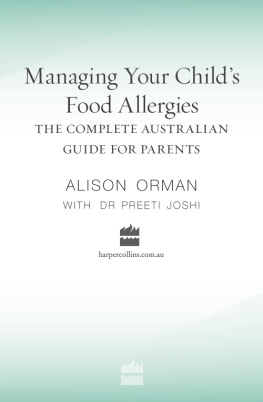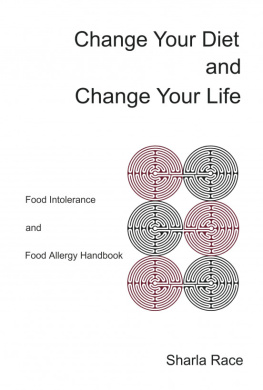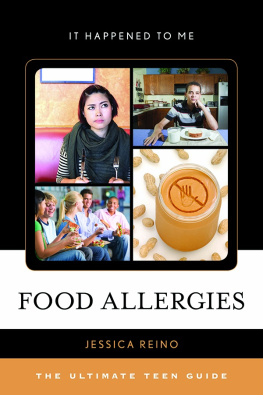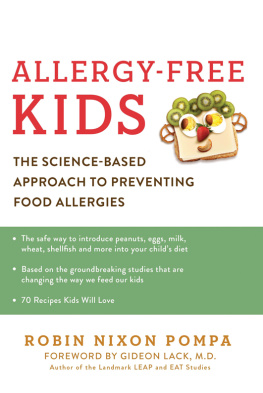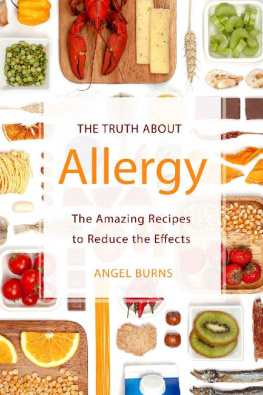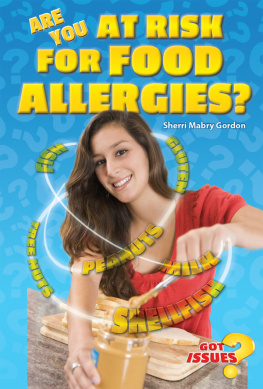Allergies and FoodAddictions
- NO MORE
****
1st EDITION
(eBook Edition)
****
A Self-Help Book for thosesuffering from Allergies and Food Addiction,
and all those who want to feel better,
physically and emotionally
****
Published by:
E.Blaurock-Busch at Smashwords
Copyright (c) 2012-2015 by E.Blaurock-Busch
All rights reserved. Withoutlimiting the rights under copyright reserved above, no part of thispublication may be reproduced, stored in or introduced into aretrieval system, or transmitted, in any form, or by any means(electronic, mechanical, photocopying, recording, or otherwise)without the prior written permission of both the copyright ownerand the above publisher of this book.
Smashwords EditionLicence Notes
This ebook is licensed for your personal enjoyment only. This ebookmay not be re-sold or given away to other people. If you would liketo share this book with another person, please purchase anadditional copy for each person you share it with. If yourereading this book and did not purchase it, or it was not purchasedfor your use only, then please return to Smashwords.com andpurchase your own copy.
****
Permission to photocopy or reproducemay be obtained from the author or
TMI - Trace MineralsInternational, LLC
****
For HolgerBuerner,
Duke ofCyberspace,
who graciously accepts thatI reluctantly enter his territory,
and
who provides the mostdelicious organic tomatoes
****
TABLE OF CONTENTS
INTRODUCTION
How Discovering My Own FoodSensitivities Has Changed My Life and That of Others
When I was a youngster in Germany,every food was health food. The worst junk food available wasplain white sugar, but since it was always scarce, we never had achance to overindulge in sweets as is commonly done today. AtEaster time eggs came straight from the farm, from hens that ranfree, feeding on grass from backyards or meadows. Before we coulddye or decorate them with onion skins or red beet juice, we had toscrub them. Thats how organic they were.
In the 1940s everybody was poor bytodays standards, and our meat supply was limited, but it camefrom happy animals. A half pound of beef, pork, chicken, rabbit,or whatever else mother managed to come up with, fed two familiesor more. (My aunt and her two children lived upstairs and we sharedthe good as well as the bad.)
There were no TV dinners orprepackaged foods and any canned goods we ate were homemade,Grandmas way. Bread came straight from the local baker who hadnever heard of or used preservatives of any kind. Hisheavenly-smelling bread was dark and firm, with a crust that gaveour teeth a good workout.
Teas came from country herbs, coffeewas made of roasted barley. We drank fresh juices in the summer andlots and lots of non-fluoridated, non-chlorinated water. Motheroften had to trade treasured family items to put food on the tableeven before war shortages began, and real American coffee was aluxury reserved for very special occasions. Milk came from theneighbors goats.
During the 1950s, Germany rose fromdestruction, a new era began. A hurt and punished people began torebuild. Ruins and ashes made room for new houses, schools andstores. Food was more readily available and a nation of people forwhom hunger had been a steady companion for decades began toindulge - and overindulge.
I was barely a teenager then andquickly developed a taste for dairy products and fancy sausages. Iregularly drank a quart a milk a day and devoured many delicioushomemade cheesecakes. Mysteriously, my health began to deteriorate.I endured headaches, was often irritable and seemed to live in afog. I also developed bladder and kidney problems, suffered throughnearly every childhood disease and eventually came down withmeningitis.
I was first treated by our familydoctor. He had been bewildered by my ailments for years, andalthough I recovered from the meningitis, my list of ailmentscontinued to grow: depression, menstrual problems, occasionalhives, etc. He was unable to help, and I continued to be tired,irritable and susceptible to colds. Most doctors I consultedattributed all of these problems to puberty and what they termedthe critical years.
It was suggested that I was toosensitive, perhaps a bit neurotic, with a tendency towardshypochondria. Later, broken friendships were held responsible.School problems were blamed on unhappiness and an unwillingness toadjust. In short, I was considered a troublemaker. I becamesuicidal.
Years later, I was assured by variousdoctors that marriage would solve all my problems (what they reallymeant was sex.) I tried both, but the problems continued. Some wisemen suggested pregnancy and motherhood, so I tried that,too.
When I was 27 I had a nervousbreakdown and developed a goiter, an enlargement of the thyroidgland that made my neck look swollen. I tired easily, suffered fromsevere hay fever and dermatitis. My energy level was constantly lowand I felt as if I had to push myself to get anything done.Endocrinologists checked me from top to bottom and gave me a cleanbill of health.
By the time I turned 30, I had prettymuch accepted my fate. Emotionally and physically, I comparedmyself to a rollercoaster. I experienced ups and terrible downs,but the downs became more frequent as time went by. I often camedown with colds. When the flu season arrived, I was the first toget sick, suffered pneumonia three times in a single year. Most ofthe time my brain seemed foggy.
Eventually, I started to askquestions. Why was I so susceptible? I ate very healthy, mostlyorganic foods. Nutritionally, I did the best I could (or so Ithought). I didnt smoke and with one beer for dinner, I was hardlyconsidered a drinker. I swallowed tons of nutritional supplementsincluding large doses of vitamin C and whatever else was consideredgood for the immune system.
But in spite of a healthy lifestyle,my health gradually deteriorated. It didnt make sense.
Then, in early 1982, I attended aseminar on food allergies and food allergy testing given by Dr.Connie Haber of Pittsburgh, PA. The presentation was intriguing andI began to study the subject. Months later, Dr. Haber came toDenver again and introduced attendees to food sensitivitytesting.
By that time I had started to applysome of the information offered in the first seminar. I had beensuccessful in helping other allergy sufferers, especially those whohad suffered severe digestive problems. After hearing Connie Haberspeak the second time, it became clear that food sensitivities cancause more than just digestive disturbances and I decided to havemyself tested.
To be quite honest, I was pretty muchconvinced that nothing much would show up. All the tests performedon me up to that point had come up negative, and I did not expectanything different.
Surprise! I soon learned that Ireacted to most of my favorite foods: dairy products, pork, barley(which is found in beer), corn, shrimp, pineapple, cabbage andgrapes.
I called Dr. Haber. Connie, I said,this is a mistake. I dont react to these foods. I eat most ofthem every day and theyve never given me any problems. Sheaccused me of being a bad listener. You bet your sweet life youreact, she said. Follow the diet and call me in threemonths.
Just to prove her wrong, I decided tostrictly follow the suggested regimen. On the tenth day I woke upearly in the morning feeling-like a new person. I had energy. I wasready to live. For the first time in my life, I felt like hoppingout of bed before sunrise. I loved every minute of that day andevery day since. Now, I worked harder, put in longer hours thanever before in my life, but I tired less. Menstrual problemsdisappeared and for the first time since childhood I feltemotionally stable, my head cleared. Disagreeable people, difficultevents hardly upset me. I finally was in charge of my life. I lovedthat feeling, still do - decades later.
Next page

